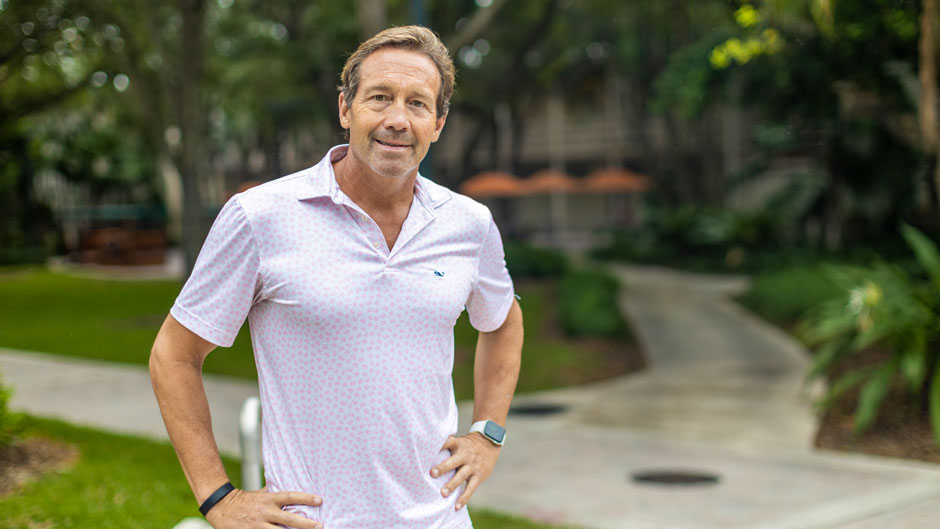When Wesley “Wes” Smith was working as a lifeguard in Ocean City, Maryland, he noticed that whenever a shore break—dangerous, violent waves crashing into shallow waters—would hit the beach, many swimmers were the victims of severe spinal injuries.
“One day, there had been five neck injuries before noon from the shore break and I said: ‘enough,’” he declared. “I pulled everyone out of the water and explained the dangers.”
There were zero injuries after that, he said.
“I learned the importance of education as a form of prevention,” he added. That realization led Smith, assistant professor of professional practice at the University of Miami School of Education and Human Development, to create software that eventually morphed into a remote monitoring system—HealthSnap—for patients with chronic diseases. Since its inception in 2018, the business is serving thousands of patients and has generated millions of dollars in revenue.
It all began in 2008 when Smith wanted to provide his pre-med exercise physiology and nutrition students with internship opportunities. Working with many health care providers that he knew and the Healthy ’Canes clinics, he placed his students in medical offices to use the software he had created to conduct assessments of patients and provide lifestyle recommendations to complement their care. This integrative system and technological platform was called the Guardrails Initiative.
Smith shared that his work was inspired by Dr. Denis Burkitt, a British surgeon and medical researcher, who once said that “If people are constantly falling off a cliff, you could place ambulances under the cliff or build a fence on the top of the cliff. We are placing all too many ambulances under the cliff.”
So, in building his fence to offer preventative health care, Smith began using evidence-based algorithms. He designed several ways to monitor key indicators in the health of patients.
“There were about 50 things we monitored and looked at, including cardiovascular fitness, blood pressure, caloric intake and expenditure, nutrition, and even posture,” he said.
Dan Morhaim, a double University alumnus with a bachelor’s degree in exercise physiology and a master’s degree in nutrition for health and human performance, began working with Guardrails as a sophomore. He would meet patients in a clinic and, if they agreed, perform a health assessment.
“The patients would do a short questionnaire about their health, and I would also ask them about their health—‘how much do you eat, how much do you sleep,’ ” he said. “It was a shotgun approach.”
The assessment took 15 to 30 minutes and the patient left the medical facility with a report giving them a comprehensive assessment of their health as well as recommendations to improve their condition. These included hydration guidelines, nutritional tips, and even strength and stretch exercises to suit their needs and prevent disease. The system also allowed the doctor to enter the patient’s information into an online portal.
Morhaim said that once the patients received their health assessment reports he would go over all the numbers on the charts and explain what they meant and which areas needed improvement.
“I think one of the best things about this program is that it allows patients to kind of look at their health in a bigger picture kind of way,” he said. “There are so many things that influence your health, such as exercise and what you eat and how active you are. It can be overwhelming.”
Morhaim now works full time for HealthSnap as a care navigator.
Eventually, to streamline the system, the researchers looked to integrate home devices and wearable technology into the health monitoring system to provide this service remotely. Norma Kenyon, vice provost for innovation and chief innovation officer for the Miller School of Medicine, was one of the first people to see that the health monitoring system had a big future.
“[Former School of Education and Human Development] dean Isaac Prilleltensky and I had been discussing innovative projects and he invited me to his office for a presentation by Dr. Smith,” said Kenyon. “As a diabetes researcher, I had seen many health-focused platforms for type 1 diabetes. I was impressed with Guardrails—it was more comprehensive, user friendly, and interesting than other technologies that I had seen.”
Kenyon told Smith that the platform could be the basis for a business.
“He gave me a look that suggested he thought I was ‘out there,’ ” she said. “It took some persuading, but Wes came around, worked with the Office of Technology Transfer and the result is HealthSnap.”
Now servicing thousands of patients nationwide, HealthSnap clients include the Montefiore Hospital System in New York, the Mayo Clinic in Jacksonville, and University trustee Phillip Frost’s company, OPKO Health.
The fact that HealthSnap is a remote patient monitoring system that offers telehealth service came in very handy during the COVID-19 pandemic, according to Smith.
“It was a serendipitous event that we had a remote-monitoring system to keep patients from hospitals. And what the pandemic required was to keep patients from hospitals,” said Smith. “We were ready to answer that need, especially for the immune-compromised patients.”
Right now, HealthSnap uses nurses to do the intake and monitoring of patients. Smith hopes that in the future the business will provide more opportunities for graduates from kinesiology programs to assist those patients. So that they can integrate the lifestyle data that is essential to optimize patient health alongside conventional treatment.
“We hope that HealthSnap will be the first of many to provide students in our field job opportunities in health care,” said Smith, who serves as the company’s chief science officer.

